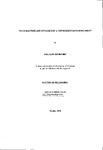THE STRUCTURE AND DYNAMICS OF A CONVERGENT ESTUARINE FRONT
| dc.contributor.author | REDBOURN, LISA JANE | |
| dc.contributor.other | Faculty of Science and Engineering | en_US |
| dc.date.accessioned | 2013-09-17T12:39:41Z | |
| dc.date.available | 2013-09-17T12:39:41Z | |
| dc.date.issued | 1996 | |
| dc.identifier | NOT AVAILABLE | en_US |
| dc.identifier.uri | http://hdl.handle.net/10026.1/1809 | |
| dc.description.abstract |
This thesis considers the structure and dynamics of a convergent front, which forms at the confluence of the Tamar and Lynher rivers during the ebb tide, in the Tamar Estuary, South West England. Temperature, salinity and velocity were sampled at high frequency in the region of frontogenesis, and these data are used to assess the evolution and development of a front during the course of an ebb tide. The equation of continuity and the horizontal equations of motion are applied to the data set in order to evaluate the dynamic regime operating in the vicinity of the front, and its spatial and temporal variation. Mixing within the region is appraised from a consideration of the vertical eddy viscosity and diffusivity, and the gradient Richardson number. Results suggest that the evolution of the front occurs in two distinct stages; the first being the formation of a convergent, near-horizontal interface between denser Tamar water flowing south-westwards, and less dense Lynher water flowing south-eastwards, such that this first stage can be described as a plume front. The interface has an increased degree of shear-induced turbulence and vertical mixing associated with it. In the later stages of the ebb tide, the front evolves into a turbulent, buoyant jet of Lynher water which extends over most of the area surveyed, and the less turbulent Tamar water is entrained into the Lynher jet. In both the longitudinal and lateral directions, the Lynher flow is found to be primarily accelerated by the barotropic pressure gradient, whereas the Tamar flow is mainly accelerated baroclinically. A markedly more variable and complex dynamic regime in the lateral direction appears to be influenced by daily variations in fresh water run-off and tidal range to a greater extent than the longitudinal dynamics. | en_US |
| dc.language.iso | en | en_US |
| dc.publisher | University of Plymouth | en_US |
| dc.title | THE STRUCTURE AND DYNAMICS OF A CONVERGENT ESTUARINE FRONT | en_US |
| dc.type | Thesis | |
| plymouth.version | Full version | en_US |
| dc.identifier.doi | http://dx.doi.org/10.24382/4145 |
Files in this item
This item appears in the following Collection(s)
-
01 Research Theses Main Collection
Research Theses Main


